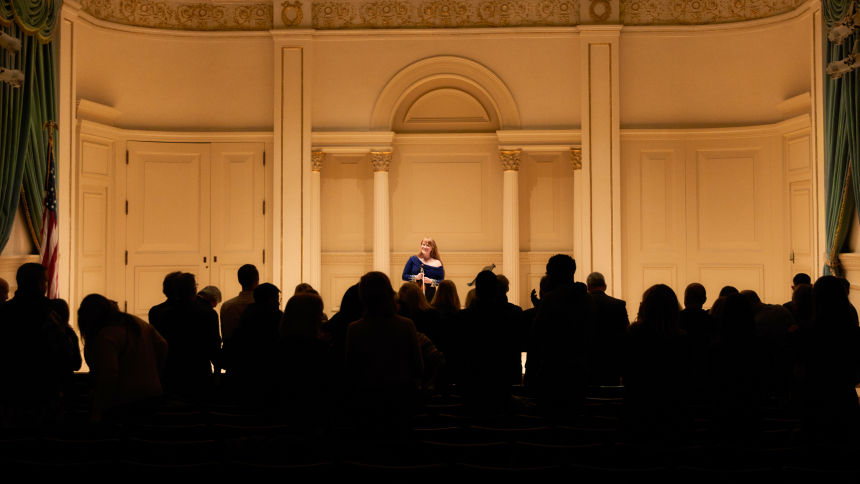
“Beethoven challenges the universe. Bach is an astronomer, discovering the most marvelous stars. I only try to express the soul and the heart of a man.” – Frédéric Chopin
PORTAGE – In about a year and a half, a local musician and instructor helped bring to life sacred music, underappreciated for centuries, and performed it at a prominent venue as it has likely never been played.
Nativity of Our Savior parishioner Megan Bonta performed a violin program at Carnegie Hall in New York City on Feb. 24, presenting Bohemian-Austrian composer and violinist Heinrich Ignaz Franz Biber’s Die Rosenkranz-Sonaten (Rosary Sonatas).
Bonta, a St. Thomas More School and Andrean High School graduate, helped bring to life the musical expressions of a Catholic composer who, though the sacred works were not published in his lifetime, dedicated 15 sonatas and one passacaglia (a complex piece written in a serious tone) for solo violin to the Church’s heavenly mission.
“It was such an honor to do my New York solo violin premiere at Carnegie Hall,” said Bonta. “The fact that I was given the opportunity to be the one to perform (the Biber compositions) for the first time live on a single violin is a dream come true.
"The reason I have so much passion for what I do is that God designed me to do it,” added Bonta, who as a young child wrote the notes to “Immaculate Mary” and played it on a violin.
Historically, Biber addressed the Archbishop of Salzburg Maximilian Gandolph von Khuenburg in the preface of the dedicated works, "I have consecrated the whole to the honour of the 15 Sacred Mysteries, which you promote so strongly."
Bonta, 32, is an instructor of stringed instruments at SoundTide Music School. She said since the fall of 2021, she took nearly every moment between clients to study Biber compositions with her husband Austin Bonta. The Andrean alumni operate the Portage studio, which opened in 2016.
She explained that her studies revolved around a “giant book” she purchased, which had page after page of Biber's musical notations and notes.
While she studied paper documents, Bonta said all of her communications with Carnegie officials was exclusively via email – from her proposal to an eventual offer for a booking date. As the nation was dealing with pandemic mitigation, she believes the protocol for paperless communications sped up the process.
As much as her husband assisted behind the scenes with his organizational skills, it would be Meg Bonta on stage, alone with her two violins: a Guarneri-style instrument she has used since she was 12, and a more recent acquisition, an Amati-style violin made in Poland in 1923.
She said the opportunity to showcase her program “A Glorious Dawn” at Carnegie Hall – Weill Recital Hall in Manhattan was the fruit of months of practice, “prayers and persistence.”
Playing and adjusting her instrument before a New York audience – re-tuning 14 times, as each piece is scordatura (tuned in a way different than standard) – she completed the Baroque-era collection performing all the changes to her instruments using specialized pegs.
“I said if I can re-tune (the violin) in under two and a half minutes, I will do it live,” explained Bonta. “That was something I was working on all the way up to a few weeks before the performance.”
For Sonata No. 11, “The Resurrection” she removed and crossed the center strings of the violin, a symbolic and tonal Biber innovation.
“Talking and tuning at the same time, it was so neat to (connect with) the audience,” Bonta said.
The program’s unique tones were designed to evoke an atmosphere and mood of what the original composer believed the scenes in the life of Jesus and his mother Mary were like in each Mystery of the Rosary – the Joyful, Sorrowful and Glorious (predating the addition of the Luminous Mysteries by St. John Paul II).
Bonta said she was “overjoyed” to be permitted to perform the Rosary Sonatas for a Big Apple audience, which included friends, family, students and the general public.
“It was really neat talking to (the hall’s) audio specialist because he’s the one who told me, ‘In 23 years I’ve heard the best of the best and I have to say this is something special,” Bonta retold.
She said another dream associated with the 17th century sonatas is to perform them for a local audience. In her book of musical manuscripts are shown engravings associated with each mystery; an ink drawing of a guardian angel and child precedes the passacaglia.
“I hope to play (the Biber compositions) live in the Midwest … hopefully at the Cathedral of the Holy Angels in Gary,” she said, noting the connection to the book art.
Each new opportunity to play or teach furthers Bonta’s self-identification as “God’s little violin.”
She believes there is a powerful form of expression taking place when audiences connect with sacred sounds.
“We were celebrating together; we share that bond of music,” Bonta said.


